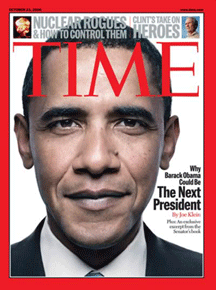
By Roger Cohen, The New York Times, April 14, 2008
When Barack Obama’s Indonesian classmates are asked to recall the boy they all called “Barry†(pronounced “Berryâ€), their description is unanimous: “chubby.â€
He was the tall, chubby kid in Bermudas who joined their 4th grade class at the Besuki elementary school in 1970, the boy with the white mother and Indonesian stepfather who brought his own sandwiches to school (odd to a noodle-eating crowd) and, strangest of all, wrote with his left hand.
“It was so weird that he was left-handed,†recalled Ati Kisjanto, now a marketing consultant. “That was considered impolite here, and you were forced to write with your right hand.â€
A dozen of Obama’s classmates were gathered at the house of Sandra Sambuaga, exchanging stories over Indonesian delicacies. For two years after Obama was elected to the Senate in 2004, they were unsure this was the boy registered at their school as Barry Soetoro (the family name of his stepfather).
“We just couldn’t believe this skinny U.S. senator with another name was our chubby, hyperactive Berry!†said Dewi Asmara Oetojo, a politician. “We were only convinced when we saw a photo of him as a boy.â€
The atmosphere at the gathering was raucous. The school was in the upscale Menteng neighborhood; everyone has done all right. A small crucifix hangs from Sambuaga’s wall: she’s a Christian. Most of the other classmates are Muslims in this country that is home to the world’s largest Muslim population.
Only Citra Dewi wore a headscarf. “I used to sit next to him and I’d say ‘Berry, move away, you’re sweating!’ †she told me. “In Indonesia we say active boys ‘smell of the sun.’ †Everyone laughed at that.
I listened and tried to imagine the 9-year-old Obama too embarrassed to sing, swapping his sandwich for sticky rice, enduring the fascination with his hair (“it kept curling back, like our noodles,†said Sambuaga).
No wonder Obama is adept at exploring the spaces in between, the areas that are neither black nor white, neither “with us†nor “against us,†neither red state nor blue state: he has spent his life building bridges to assemble a coherent identity. Only by uniting disparate threads could he become whole under the name of Barack Obama in a world experienced as defined by divergent truths.
One such many-shaded truth was religion. His stepfather, according to Obama’s memoir, “followed a brand of Islam that could make room for the remnants of more ancient animist and Hindu faiths.†That tracks with the pliant, tropical Islam of Indonesia where a “you shall have your religion, and I shall have mine†tolerance dwarfs pockets of radicalism.
The United States has an Islam problem. Say the name of the religion of almost 20 percent of the world’s population and images of bearded, Wahhabi extremists surge. They reflect a reductive unease born of 9/11 and ignorance. A central challenge of the next president will be reinventing America’s relations with the Islamic world, and stimulating open dialogue between Muslims.
Obama has lived with Islam, from his boyhood Indonesia to a later encounter with the similarly malleable Islamic faith of Kenyan relatives. He can situate Saudi Wahhabism as one current among many. With Islam as with most things, it’s better to deal with a multi-faced reality than simplified demons.
I’m troubled by Hillary Clinton’s recent innuendo-dripping remark that her Christian faith “is the faith of my parents and my grandparents.†As opposed, of course, to Obama, who came to Christianity from a mother whose “secular humanism†held that “rational, thoughtful people could shape their own destiny,†and a Kenyan father born into a Muslim family, and a Muslim stepfather.
We live in the Age of Interaction. Fluidity and connectedness define the world, forging hybrid identities not fixed in formaldehyde. Clinton, on an Obama-is-aloof kick, now says she’s a pro-gun churchgoer. That may play in west Pennsylvania but won’t bridge the national and international chasms Bush bequeaths.
“I used to support Hillary, but now I look at her eyes and see someone always wired, always calculating, whereas in Berry I see some wisdom,†said Kisjanto.
I went to the school, where there’s a huge photograph of pilgrims at Mecca in the entrance; I imagined Fox News filming it one day to pronounce the place a Madrasa. It’s nothing of the sort. It’s a state school whose students are 85 percent Muslim, a little below the national average.
There’s a mosque and a small Christian prayer room with a sign saying: “I understand we are all different and include everyone.†Kuwadiyanto, the principal, told me: “Christians and Muslim kids mix easily. Maybe more Americans should come here to see what’s really happening.â€
Obama already has. He’s shed his chubbiness but not Indonesia’s lesson, emblazoned on the national coat of arms, of “unity in diversity.â€
Blog: